Analysis of Behavioural Aspects of Budgeting and Budgetary Process
VerifiedAdded on 2023/01/13
|8
|2088
|83
Report
AI Summary
This report provides a comprehensive overview of the behavioral aspects of budgeting and the sequence of the budgetary process. It begins by introducing the concept of budgeting as a crucial tool for business management, emphasizing its role in strategic planning, resource allocation, and performance evaluation. The report then delves into the essential stages of the budgeting process, including mission specification, strategy selection, budgetary planning, and budgetary control. It further examines the sequence of the budgetary process, highlighting key steps such as communicating objectives and strategies, establishing procedures, determining limiting factors, preparing initial budgets, and conducting reviews. The report also explores the behavioral aspects of budgeting, such as motivation, participation, and budget slack, along with the limitations of the budgetary process. It concludes by emphasizing the importance of budgeting as a valuable managerial tool, despite its weaknesses, for planning, resource management, and coordination within the organization.
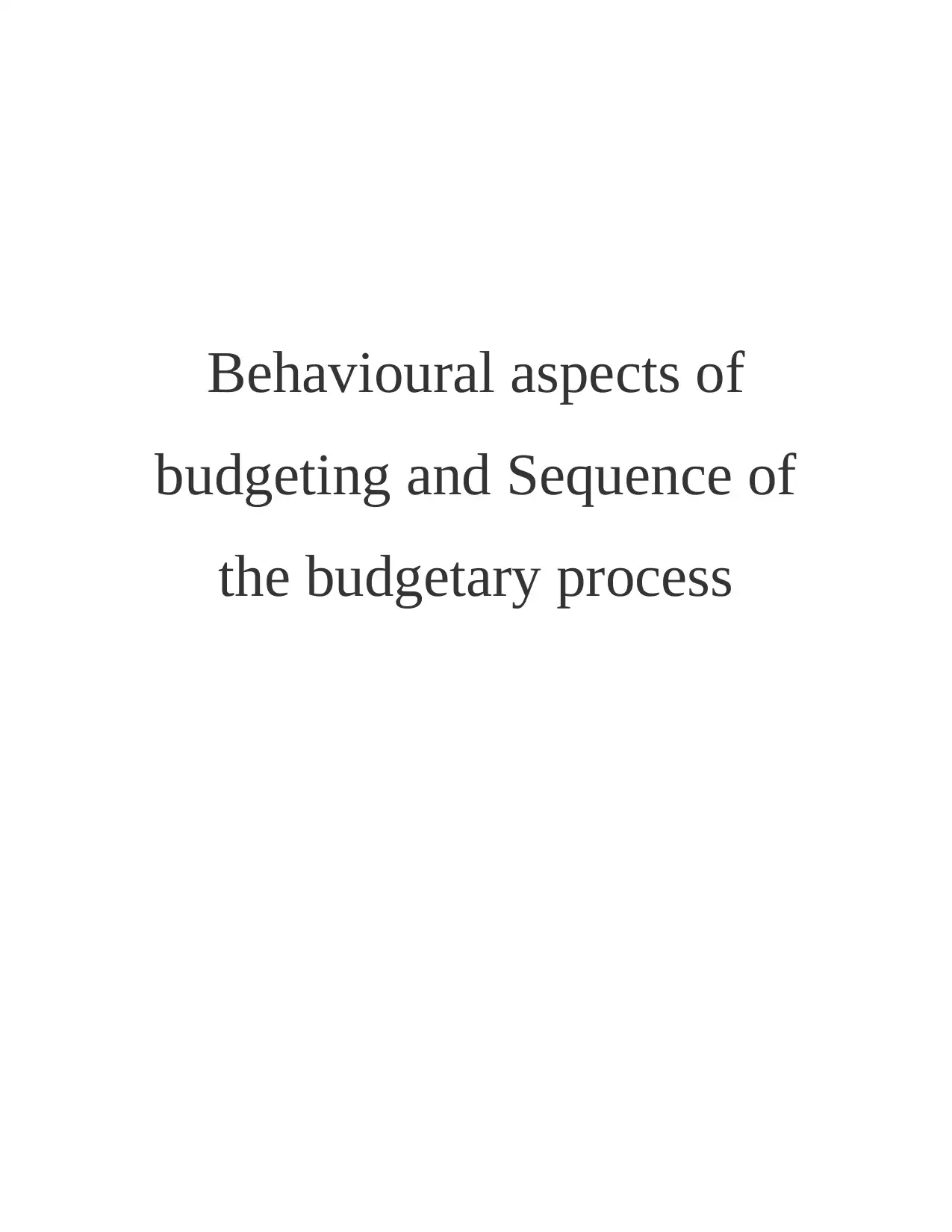
Behavioural aspects of
budgeting and Sequence of
the budgetary process
budgeting and Sequence of
the budgetary process
Paraphrase This Document
Need a fresh take? Get an instant paraphrase of this document with our AI Paraphraser
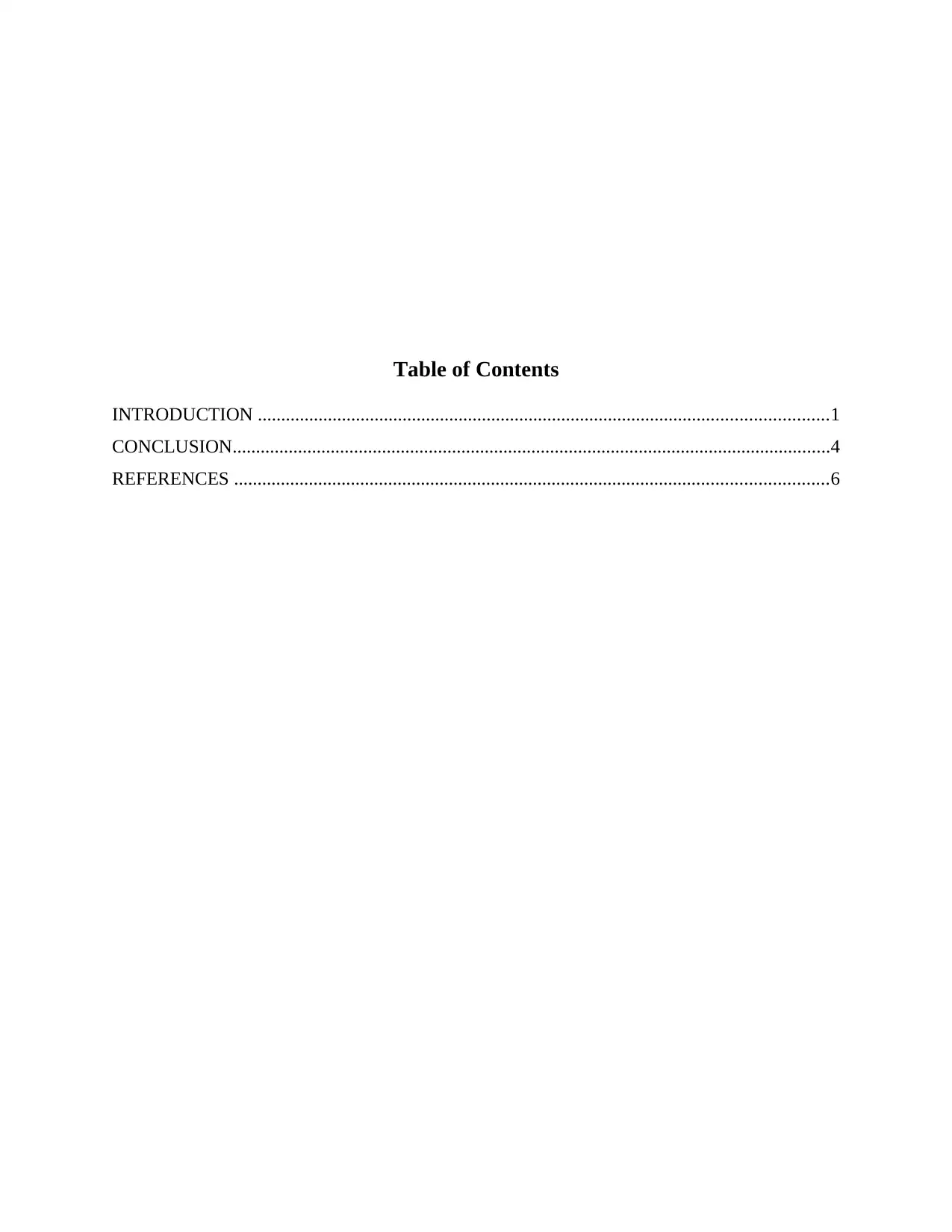
Table of Contents
INTRODUCTION ..........................................................................................................................1
CONCLUSION................................................................................................................................4
REFERENCES ...............................................................................................................................6
INTRODUCTION ..........................................................................................................................1
CONCLUSION................................................................................................................................4
REFERENCES ...............................................................................................................................6
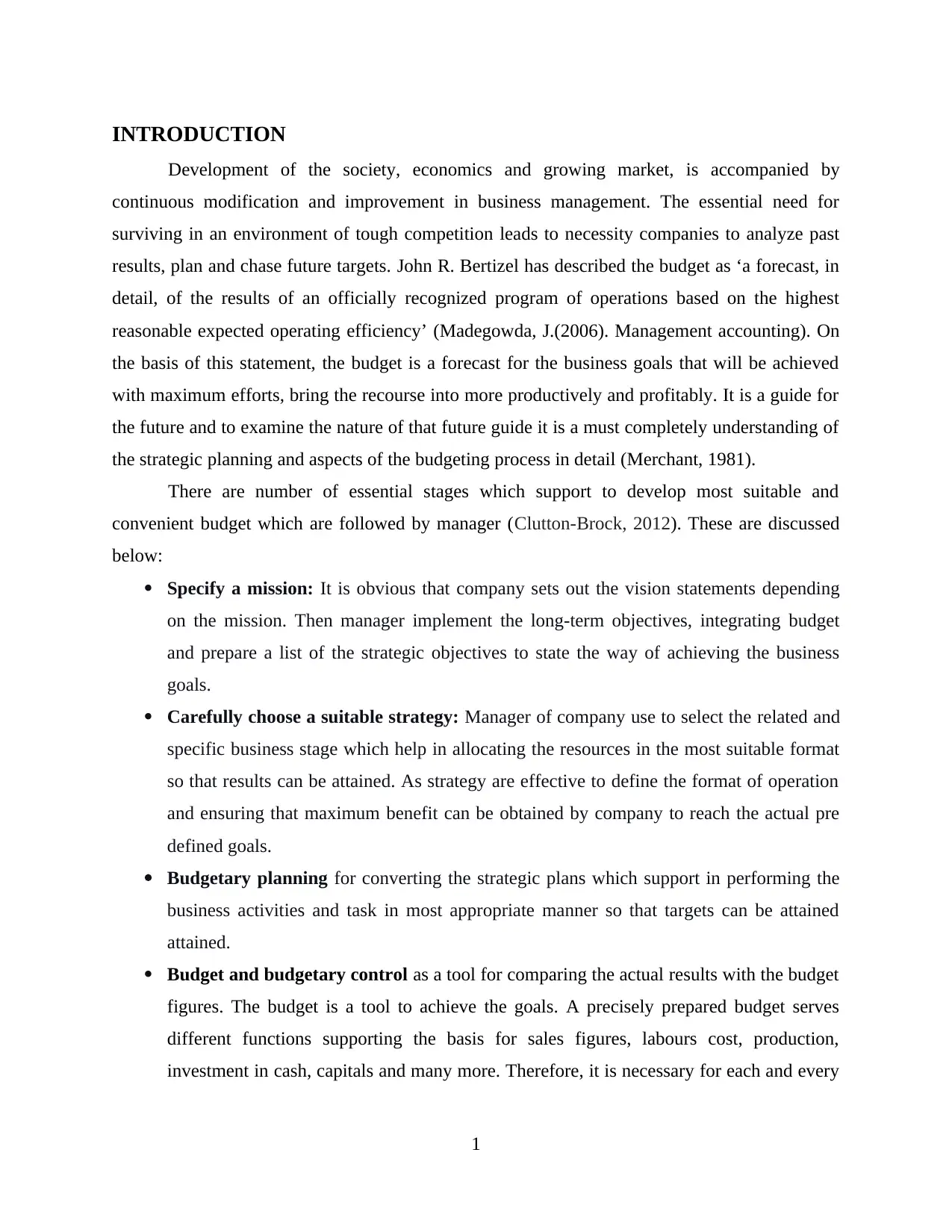
INTRODUCTION
Development of the society, economics and growing market, is accompanied by
continuous modification and improvement in business management. The essential need for
surviving in an environment of tough competition leads to necessity companies to analyze past
results, plan and chase future targets. John R. Bertizel has described the budget as ‘a forecast, in
detail, of the results of an officially recognized program of operations based on the highest
reasonable expected operating efficiency’ (Madegowda, J.(2006). Management accounting). On
the basis of this statement, the budget is a forecast for the business goals that will be achieved
with maximum efforts, bring the recourse into more productively and profitably. It is a guide for
the future and to examine the nature of that future guide it is a must completely understanding of
the strategic planning and aspects of the budgeting process in detail (Merchant, 1981).
There are number of essential stages which support to develop most suitable and
convenient budget which are followed by manager (Clutton-Brock, 2012). These are discussed
below:
Specify a mission: It is obvious that company sets out the vision statements depending
on the mission. Then manager implement the long-term objectives, integrating budget
and prepare a list of the strategic objectives to state the way of achieving the business
goals.
Carefully choose a suitable strategy: Manager of company use to select the related and
specific business stage which help in allocating the resources in the most suitable format
so that results can be attained. As strategy are effective to define the format of operation
and ensuring that maximum benefit can be obtained by company to reach the actual pre
defined goals.
Budgetary planning for converting the strategic plans which support in performing the
business activities and task in most appropriate manner so that targets can be attained
attained.
Budget and budgetary control as a tool for comparing the actual results with the budget
figures. The budget is a tool to achieve the goals. A precisely prepared budget serves
different functions supporting the basis for sales figures, labours cost, production,
investment in cash, capitals and many more. Therefore, it is necessary for each and every
1
Development of the society, economics and growing market, is accompanied by
continuous modification and improvement in business management. The essential need for
surviving in an environment of tough competition leads to necessity companies to analyze past
results, plan and chase future targets. John R. Bertizel has described the budget as ‘a forecast, in
detail, of the results of an officially recognized program of operations based on the highest
reasonable expected operating efficiency’ (Madegowda, J.(2006). Management accounting). On
the basis of this statement, the budget is a forecast for the business goals that will be achieved
with maximum efforts, bring the recourse into more productively and profitably. It is a guide for
the future and to examine the nature of that future guide it is a must completely understanding of
the strategic planning and aspects of the budgeting process in detail (Merchant, 1981).
There are number of essential stages which support to develop most suitable and
convenient budget which are followed by manager (Clutton-Brock, 2012). These are discussed
below:
Specify a mission: It is obvious that company sets out the vision statements depending
on the mission. Then manager implement the long-term objectives, integrating budget
and prepare a list of the strategic objectives to state the way of achieving the business
goals.
Carefully choose a suitable strategy: Manager of company use to select the related and
specific business stage which help in allocating the resources in the most suitable format
so that results can be attained. As strategy are effective to define the format of operation
and ensuring that maximum benefit can be obtained by company to reach the actual pre
defined goals.
Budgetary planning for converting the strategic plans which support in performing the
business activities and task in most appropriate manner so that targets can be attained
attained.
Budget and budgetary control as a tool for comparing the actual results with the budget
figures. The budget is a tool to achieve the goals. A precisely prepared budget serves
different functions supporting the basis for sales figures, labours cost, production,
investment in cash, capitals and many more. Therefore, it is necessary for each and every
1
⊘ This is a preview!⊘
Do you want full access?
Subscribe today to unlock all pages.

Trusted by 1+ million students worldwide
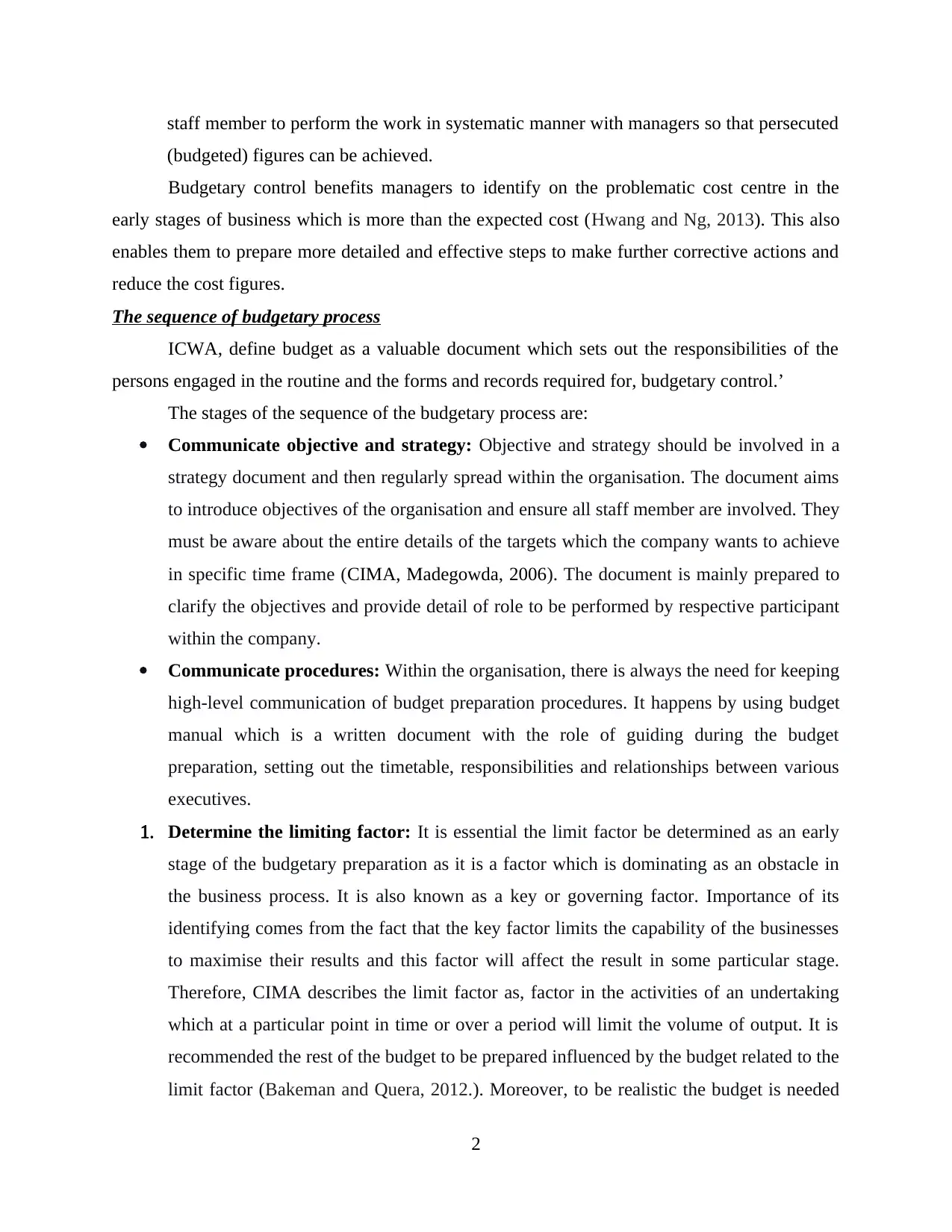
staff member to perform the work in systematic manner with managers so that persecuted
(budgeted) figures can be achieved.
Budgetary control benefits managers to identify on the problematic cost centre in the
early stages of business which is more than the expected cost (Hwang and Ng, 2013). This also
enables them to prepare more detailed and effective steps to make further corrective actions and
reduce the cost figures.
The sequence of budgetary process
ICWA, define budget as a valuable document which sets out the responsibilities of the
persons engaged in the routine and the forms and records required for, budgetary control.’
The stages of the sequence of the budgetary process are:
Communicate objective and strategy: Objective and strategy should be involved in a
strategy document and then regularly spread within the organisation. The document aims
to introduce objectives of the organisation and ensure all staff member are involved. They
must be aware about the entire details of the targets which the company wants to achieve
in specific time frame (CIMA, Madegowda, 2006). The document is mainly prepared to
clarify the objectives and provide detail of role to be performed by respective participant
within the company.
Communicate procedures: Within the organisation, there is always the need for keeping
high-level communication of budget preparation procedures. It happens by using budget
manual which is a written document with the role of guiding during the budget
preparation, setting out the timetable, responsibilities and relationships between various
executives.
1. Determine the limiting factor: It is essential the limit factor be determined as an early
stage of the budgetary preparation as it is a factor which is dominating as an obstacle in
the business process. It is also known as a key or governing factor. Importance of its
identifying comes from the fact that the key factor limits the capability of the businesses
to maximise their results and this factor will affect the result in some particular stage.
Therefore, CIMA describes the limit factor as, factor in the activities of an undertaking
which at a particular point in time or over a period will limit the volume of output. It is
recommended the rest of the budget to be prepared influenced by the budget related to the
limit factor (Bakeman and Quera, 2012.). Moreover, to be realistic the budget is needed
2
(budgeted) figures can be achieved.
Budgetary control benefits managers to identify on the problematic cost centre in the
early stages of business which is more than the expected cost (Hwang and Ng, 2013). This also
enables them to prepare more detailed and effective steps to make further corrective actions and
reduce the cost figures.
The sequence of budgetary process
ICWA, define budget as a valuable document which sets out the responsibilities of the
persons engaged in the routine and the forms and records required for, budgetary control.’
The stages of the sequence of the budgetary process are:
Communicate objective and strategy: Objective and strategy should be involved in a
strategy document and then regularly spread within the organisation. The document aims
to introduce objectives of the organisation and ensure all staff member are involved. They
must be aware about the entire details of the targets which the company wants to achieve
in specific time frame (CIMA, Madegowda, 2006). The document is mainly prepared to
clarify the objectives and provide detail of role to be performed by respective participant
within the company.
Communicate procedures: Within the organisation, there is always the need for keeping
high-level communication of budget preparation procedures. It happens by using budget
manual which is a written document with the role of guiding during the budget
preparation, setting out the timetable, responsibilities and relationships between various
executives.
1. Determine the limiting factor: It is essential the limit factor be determined as an early
stage of the budgetary preparation as it is a factor which is dominating as an obstacle in
the business process. It is also known as a key or governing factor. Importance of its
identifying comes from the fact that the key factor limits the capability of the businesses
to maximise their results and this factor will affect the result in some particular stage.
Therefore, CIMA describes the limit factor as, factor in the activities of an undertaking
which at a particular point in time or over a period will limit the volume of output. It is
recommended the rest of the budget to be prepared influenced by the budget related to the
limit factor (Bakeman and Quera, 2012.). Moreover, to be realistic the budget is needed
2
Paraphrase This Document
Need a fresh take? Get an instant paraphrase of this document with our AI Paraphraser
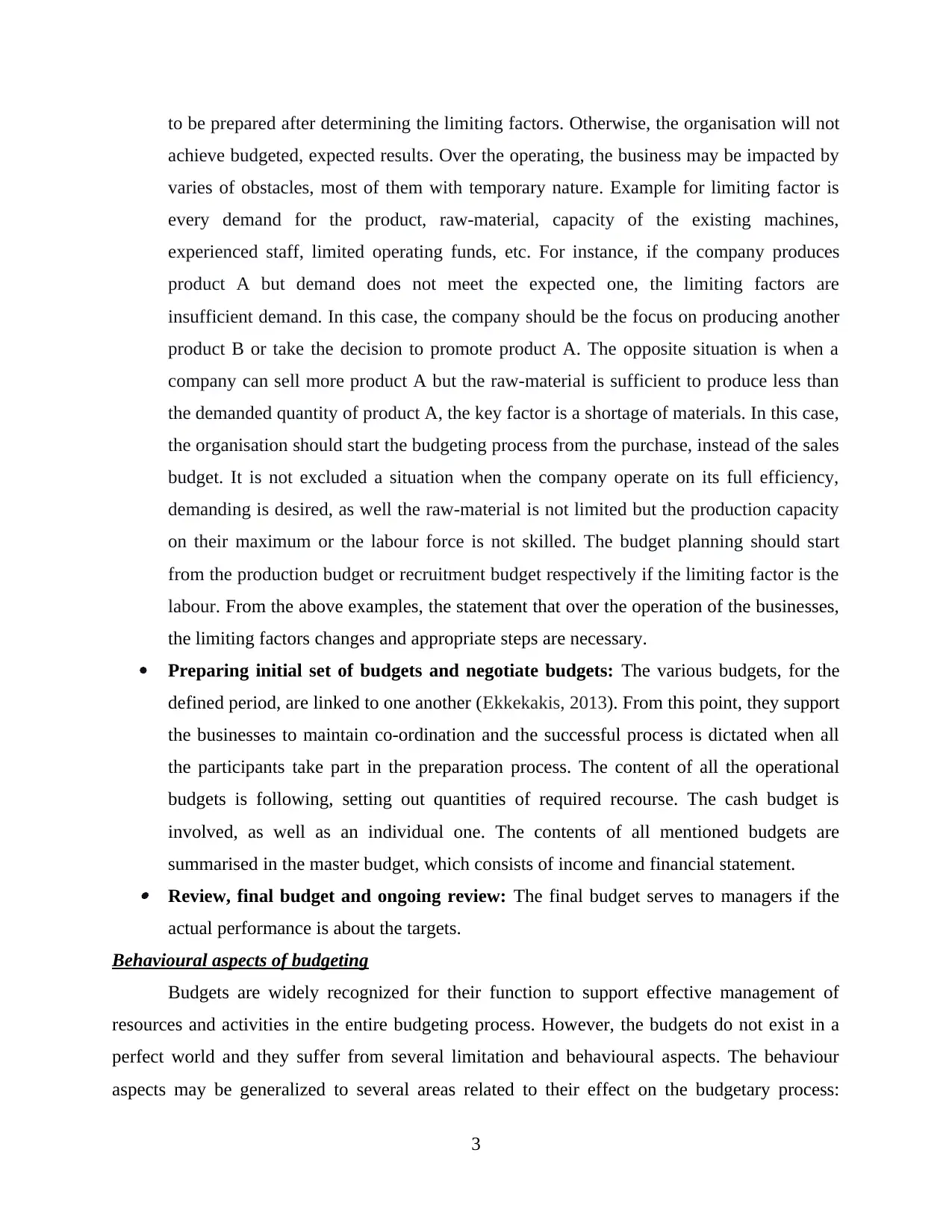
to be prepared after determining the limiting factors. Otherwise, the organisation will not
achieve budgeted, expected results. Over the operating, the business may be impacted by
varies of obstacles, most of them with temporary nature. Example for limiting factor is
every demand for the product, raw-material, capacity of the existing machines,
experienced staff, limited operating funds, etc. For instance, if the company produces
product A but demand does not meet the expected one, the limiting factors are
insufficient demand. In this case, the company should be the focus on producing another
product B or take the decision to promote product A. The opposite situation is when a
company can sell more product A but the raw-material is sufficient to produce less than
the demanded quantity of product A, the key factor is a shortage of materials. In this case,
the organisation should start the budgeting process from the purchase, instead of the sales
budget. It is not excluded a situation when the company operate on its full efficiency,
demanding is desired, as well the raw-material is not limited but the production capacity
on their maximum or the labour force is not skilled. The budget planning should start
from the production budget or recruitment budget respectively if the limiting factor is the
labour. From the above examples, the statement that over the operation of the businesses,
the limiting factors changes and appropriate steps are necessary.
Preparing initial set of budgets and negotiate budgets: The various budgets, for the
defined period, are linked to one another (Ekkekakis, 2013). From this point, they support
the businesses to maintain co-ordination and the successful process is dictated when all
the participants take part in the preparation process. The content of all the operational
budgets is following, setting out quantities of required recourse. The cash budget is
involved, as well as an individual one. The contents of all mentioned budgets are
summarised in the master budget, which consists of income and financial statement. Review, final budget and ongoing review: The final budget serves to managers if the
actual performance is about the targets.
Behavioural aspects of budgeting
Budgets are widely recognized for their function to support effective management of
resources and activities in the entire budgeting process. However, the budgets do not exist in a
perfect world and they suffer from several limitation and behavioural aspects. The behaviour
aspects may be generalized to several areas related to their effect on the budgetary process:
3
achieve budgeted, expected results. Over the operating, the business may be impacted by
varies of obstacles, most of them with temporary nature. Example for limiting factor is
every demand for the product, raw-material, capacity of the existing machines,
experienced staff, limited operating funds, etc. For instance, if the company produces
product A but demand does not meet the expected one, the limiting factors are
insufficient demand. In this case, the company should be the focus on producing another
product B or take the decision to promote product A. The opposite situation is when a
company can sell more product A but the raw-material is sufficient to produce less than
the demanded quantity of product A, the key factor is a shortage of materials. In this case,
the organisation should start the budgeting process from the purchase, instead of the sales
budget. It is not excluded a situation when the company operate on its full efficiency,
demanding is desired, as well the raw-material is not limited but the production capacity
on their maximum or the labour force is not skilled. The budget planning should start
from the production budget or recruitment budget respectively if the limiting factor is the
labour. From the above examples, the statement that over the operation of the businesses,
the limiting factors changes and appropriate steps are necessary.
Preparing initial set of budgets and negotiate budgets: The various budgets, for the
defined period, are linked to one another (Ekkekakis, 2013). From this point, they support
the businesses to maintain co-ordination and the successful process is dictated when all
the participants take part in the preparation process. The content of all the operational
budgets is following, setting out quantities of required recourse. The cash budget is
involved, as well as an individual one. The contents of all mentioned budgets are
summarised in the master budget, which consists of income and financial statement. Review, final budget and ongoing review: The final budget serves to managers if the
actual performance is about the targets.
Behavioural aspects of budgeting
Budgets are widely recognized for their function to support effective management of
resources and activities in the entire budgeting process. However, the budgets do not exist in a
perfect world and they suffer from several limitation and behavioural aspects. The behaviour
aspects may be generalized to several areas related to their effect on the budgetary process:
3
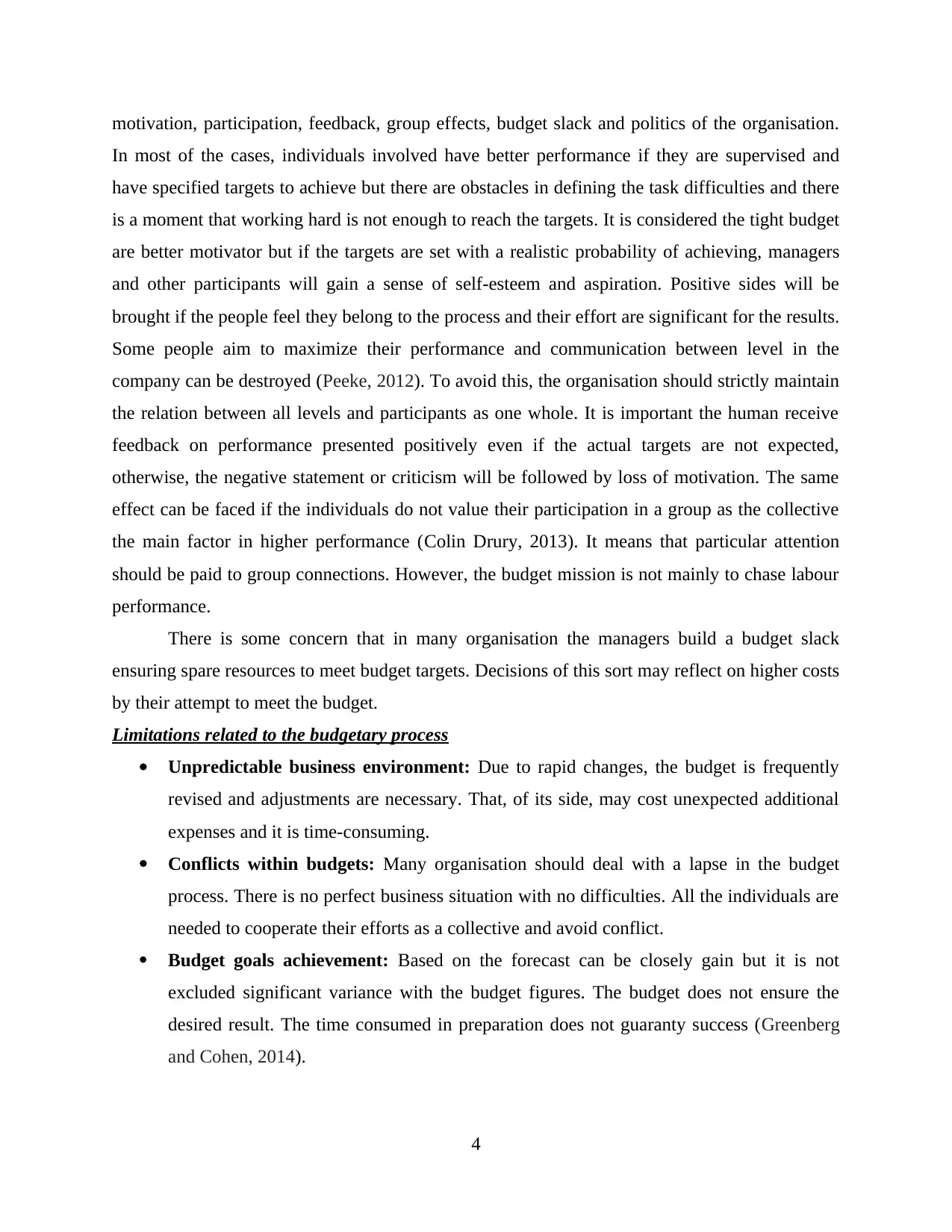
motivation, participation, feedback, group effects, budget slack and politics of the organisation.
In most of the cases, individuals involved have better performance if they are supervised and
have specified targets to achieve but there are obstacles in defining the task difficulties and there
is a moment that working hard is not enough to reach the targets. It is considered the tight budget
are better motivator but if the targets are set with a realistic probability of achieving, managers
and other participants will gain a sense of self-esteem and aspiration. Positive sides will be
brought if the people feel they belong to the process and their effort are significant for the results.
Some people aim to maximize their performance and communication between level in the
company can be destroyed (Peeke, 2012). To avoid this, the organisation should strictly maintain
the relation between all levels and participants as one whole. It is important the human receive
feedback on performance presented positively even if the actual targets are not expected,
otherwise, the negative statement or criticism will be followed by loss of motivation. The same
effect can be faced if the individuals do not value their participation in a group as the collective
the main factor in higher performance (Colin Drury, 2013). It means that particular attention
should be paid to group connections. However, the budget mission is not mainly to chase labour
performance.
There is some concern that in many organisation the managers build a budget slack
ensuring spare resources to meet budget targets. Decisions of this sort may reflect on higher costs
by their attempt to meet the budget.
Limitations related to the budgetary process
Unpredictable business environment: Due to rapid changes, the budget is frequently
revised and adjustments are necessary. That, of its side, may cost unexpected additional
expenses and it is time-consuming.
Conflicts within budgets: Many organisation should deal with a lapse in the budget
process. There is no perfect business situation with no difficulties. All the individuals are
needed to cooperate their efforts as a collective and avoid conflict.
Budget goals achievement: Based on the forecast can be closely gain but it is not
excluded significant variance with the budget figures. The budget does not ensure the
desired result. The time consumed in preparation does not guaranty success (Greenberg
and Cohen, 2014).
4
In most of the cases, individuals involved have better performance if they are supervised and
have specified targets to achieve but there are obstacles in defining the task difficulties and there
is a moment that working hard is not enough to reach the targets. It is considered the tight budget
are better motivator but if the targets are set with a realistic probability of achieving, managers
and other participants will gain a sense of self-esteem and aspiration. Positive sides will be
brought if the people feel they belong to the process and their effort are significant for the results.
Some people aim to maximize their performance and communication between level in the
company can be destroyed (Peeke, 2012). To avoid this, the organisation should strictly maintain
the relation between all levels and participants as one whole. It is important the human receive
feedback on performance presented positively even if the actual targets are not expected,
otherwise, the negative statement or criticism will be followed by loss of motivation. The same
effect can be faced if the individuals do not value their participation in a group as the collective
the main factor in higher performance (Colin Drury, 2013). It means that particular attention
should be paid to group connections. However, the budget mission is not mainly to chase labour
performance.
There is some concern that in many organisation the managers build a budget slack
ensuring spare resources to meet budget targets. Decisions of this sort may reflect on higher costs
by their attempt to meet the budget.
Limitations related to the budgetary process
Unpredictable business environment: Due to rapid changes, the budget is frequently
revised and adjustments are necessary. That, of its side, may cost unexpected additional
expenses and it is time-consuming.
Conflicts within budgets: Many organisation should deal with a lapse in the budget
process. There is no perfect business situation with no difficulties. All the individuals are
needed to cooperate their efforts as a collective and avoid conflict.
Budget goals achievement: Based on the forecast can be closely gain but it is not
excluded significant variance with the budget figures. The budget does not ensure the
desired result. The time consumed in preparation does not guaranty success (Greenberg
and Cohen, 2014).
4
⊘ This is a preview!⊘
Do you want full access?
Subscribe today to unlock all pages.

Trusted by 1+ million students worldwide
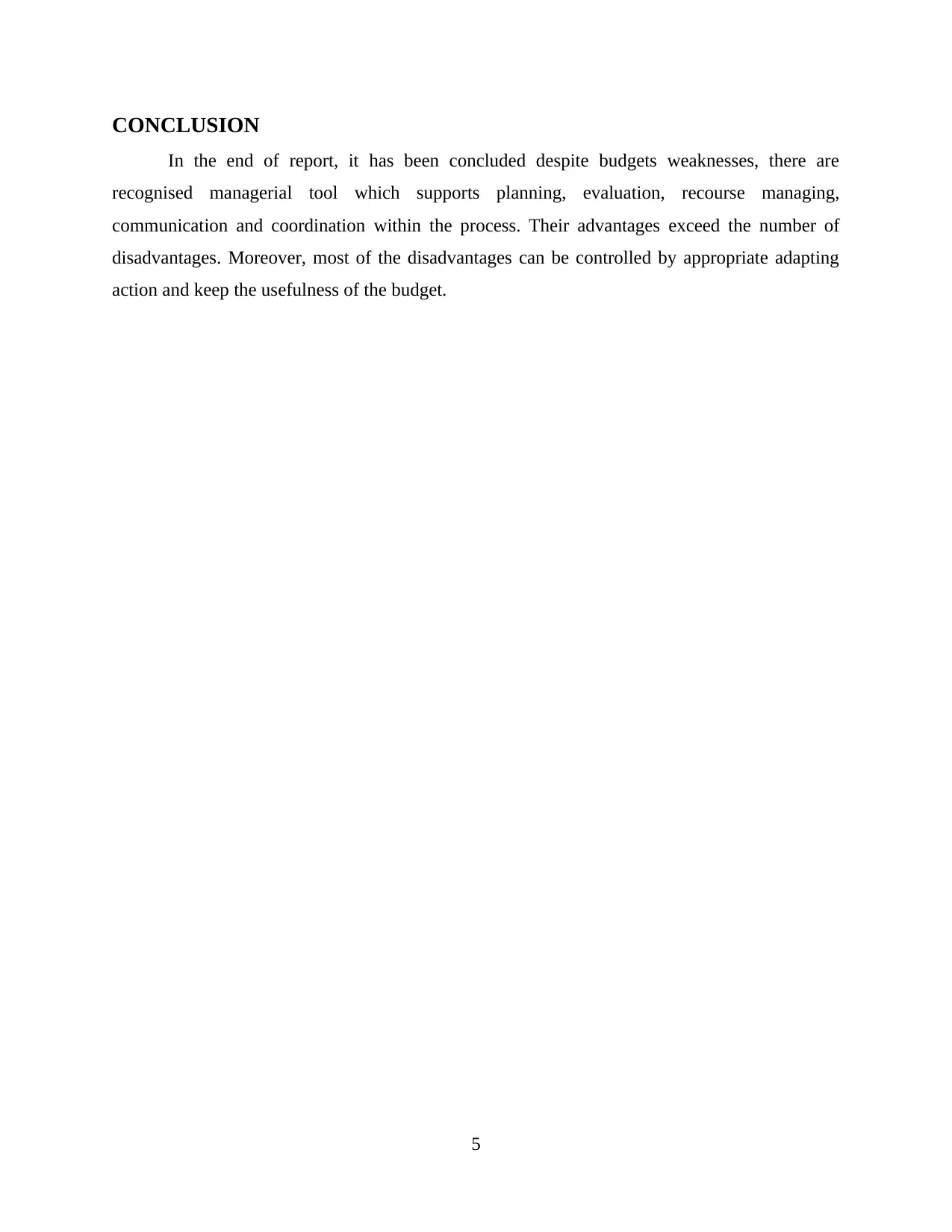
CONCLUSION
In the end of report, it has been concluded despite budgets weaknesses, there are
recognised managerial tool which supports planning, evaluation, recourse managing,
communication and coordination within the process. Their advantages exceed the number of
disadvantages. Moreover, most of the disadvantages can be controlled by appropriate adapting
action and keep the usefulness of the budget.
5
In the end of report, it has been concluded despite budgets weaknesses, there are
recognised managerial tool which supports planning, evaluation, recourse managing,
communication and coordination within the process. Their advantages exceed the number of
disadvantages. Moreover, most of the disadvantages can be controlled by appropriate adapting
action and keep the usefulness of the budget.
5
Paraphrase This Document
Need a fresh take? Get an instant paraphrase of this document with our AI Paraphraser
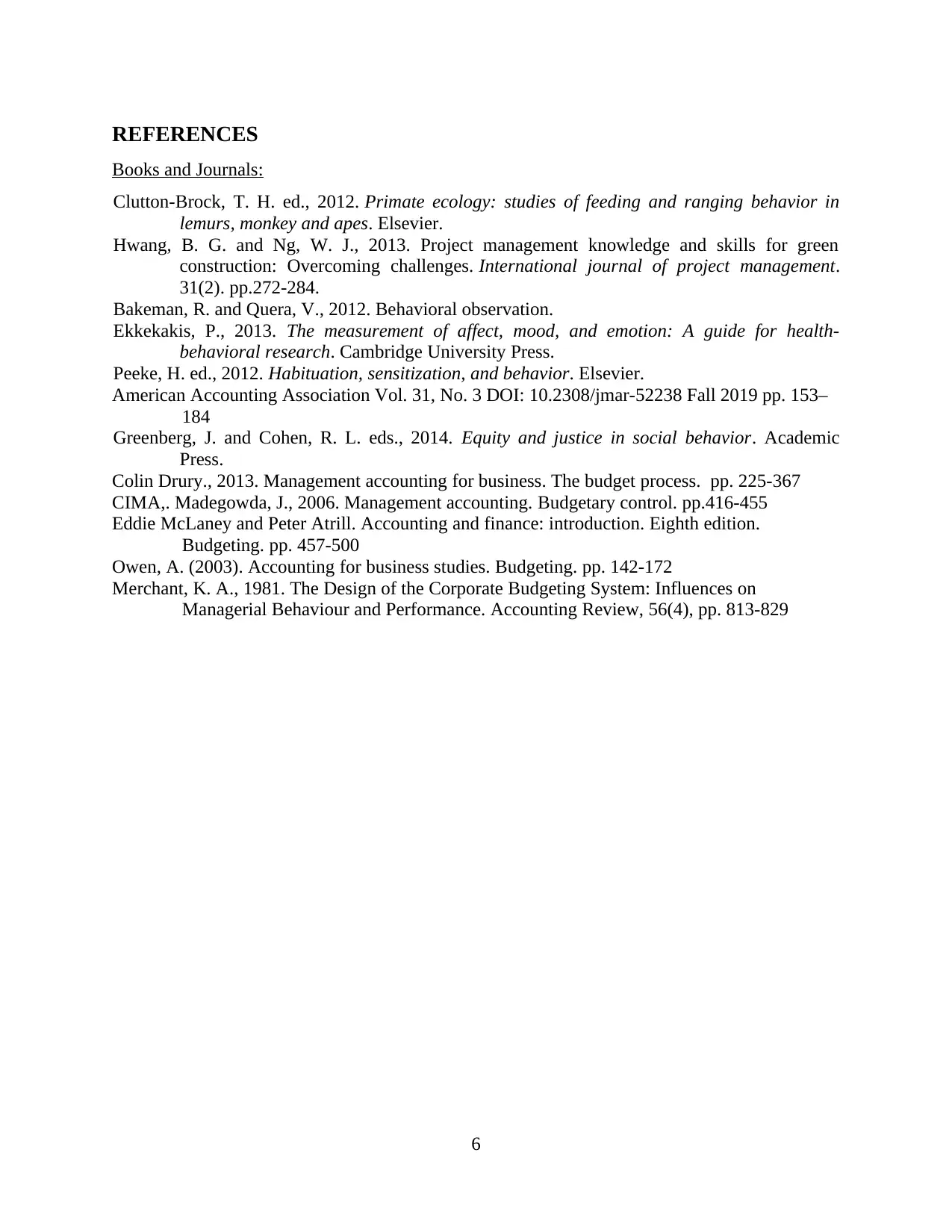
REFERENCES
Books and Journals:
Clutton-Brock, T. H. ed., 2012. Primate ecology: studies of feeding and ranging behavior in
lemurs, monkey and apes. Elsevier.
Hwang, B. G. and Ng, W. J., 2013. Project management knowledge and skills for green
construction: Overcoming challenges. International journal of project management.
31(2). pp.272-284.
Bakeman, R. and Quera, V., 2012. Behavioral observation.
Ekkekakis, P., 2013. The measurement of affect, mood, and emotion: A guide for health-
behavioral research. Cambridge University Press.
Peeke, H. ed., 2012. Habituation, sensitization, and behavior. Elsevier.
American Accounting Association Vol. 31, No. 3 DOI: 10.2308/jmar-52238 Fall 2019 pp. 153–
184
Greenberg, J. and Cohen, R. L. eds., 2014. Equity and justice in social behavior. Academic
Press.
Colin Drury., 2013. Management accounting for business. The budget process. pp. 225-367
CIMA,. Madegowda, J., 2006. Management accounting. Budgetary control. pp.416-455
Eddie McLaney and Peter Atrill. Accounting and finance: introduction. Eighth edition.
Budgeting. pp. 457-500
Owen, A. (2003). Accounting for business studies. Budgeting. pp. 142-172
Merchant, K. A., 1981. The Design of the Corporate Budgeting System: Influences on
Managerial Behaviour and Performance. Accounting Review, 56(4), pp. 813-829
6
Books and Journals:
Clutton-Brock, T. H. ed., 2012. Primate ecology: studies of feeding and ranging behavior in
lemurs, monkey and apes. Elsevier.
Hwang, B. G. and Ng, W. J., 2013. Project management knowledge and skills for green
construction: Overcoming challenges. International journal of project management.
31(2). pp.272-284.
Bakeman, R. and Quera, V., 2012. Behavioral observation.
Ekkekakis, P., 2013. The measurement of affect, mood, and emotion: A guide for health-
behavioral research. Cambridge University Press.
Peeke, H. ed., 2012. Habituation, sensitization, and behavior. Elsevier.
American Accounting Association Vol. 31, No. 3 DOI: 10.2308/jmar-52238 Fall 2019 pp. 153–
184
Greenberg, J. and Cohen, R. L. eds., 2014. Equity and justice in social behavior. Academic
Press.
Colin Drury., 2013. Management accounting for business. The budget process. pp. 225-367
CIMA,. Madegowda, J., 2006. Management accounting. Budgetary control. pp.416-455
Eddie McLaney and Peter Atrill. Accounting and finance: introduction. Eighth edition.
Budgeting. pp. 457-500
Owen, A. (2003). Accounting for business studies. Budgeting. pp. 142-172
Merchant, K. A., 1981. The Design of the Corporate Budgeting System: Influences on
Managerial Behaviour and Performance. Accounting Review, 56(4), pp. 813-829
6
1 out of 8
Related Documents
Your All-in-One AI-Powered Toolkit for Academic Success.
+13062052269
info@desklib.com
Available 24*7 on WhatsApp / Email
![[object Object]](/_next/static/media/star-bottom.7253800d.svg)
Unlock your academic potential
Copyright © 2020–2025 A2Z Services. All Rights Reserved. Developed and managed by ZUCOL.




